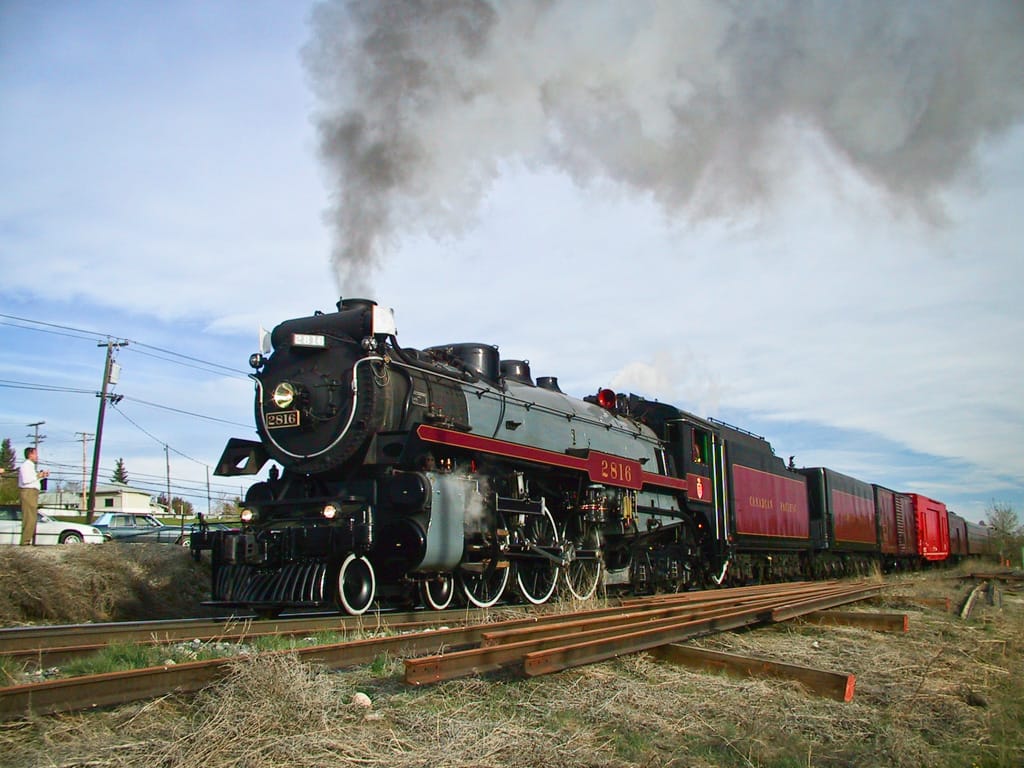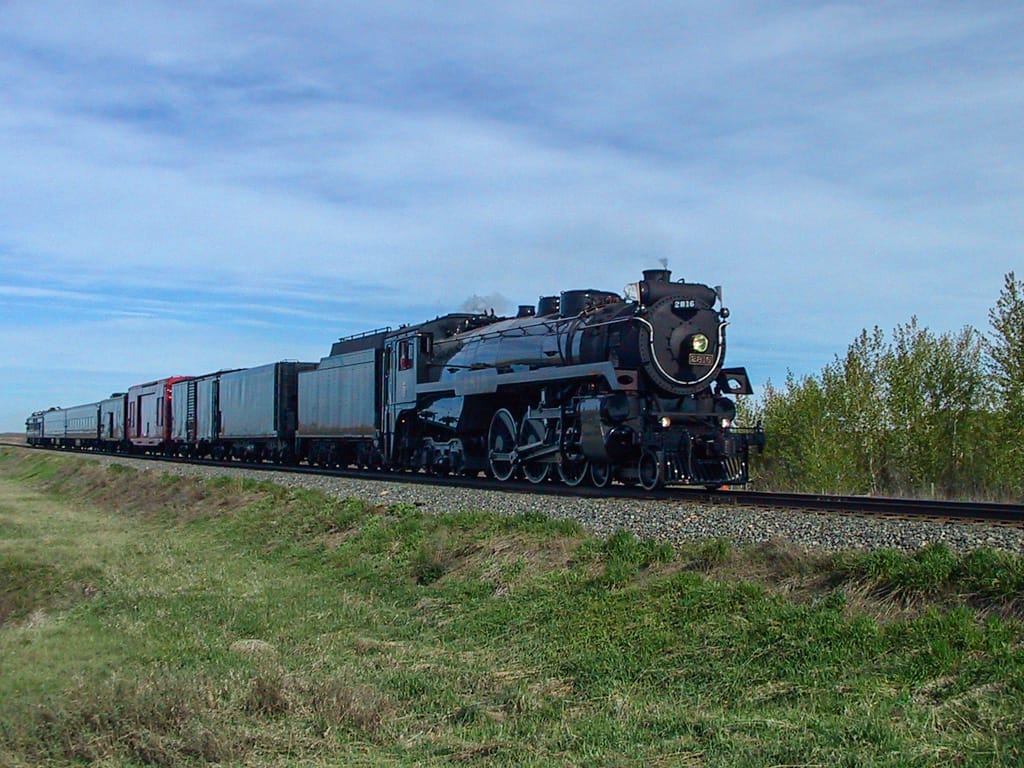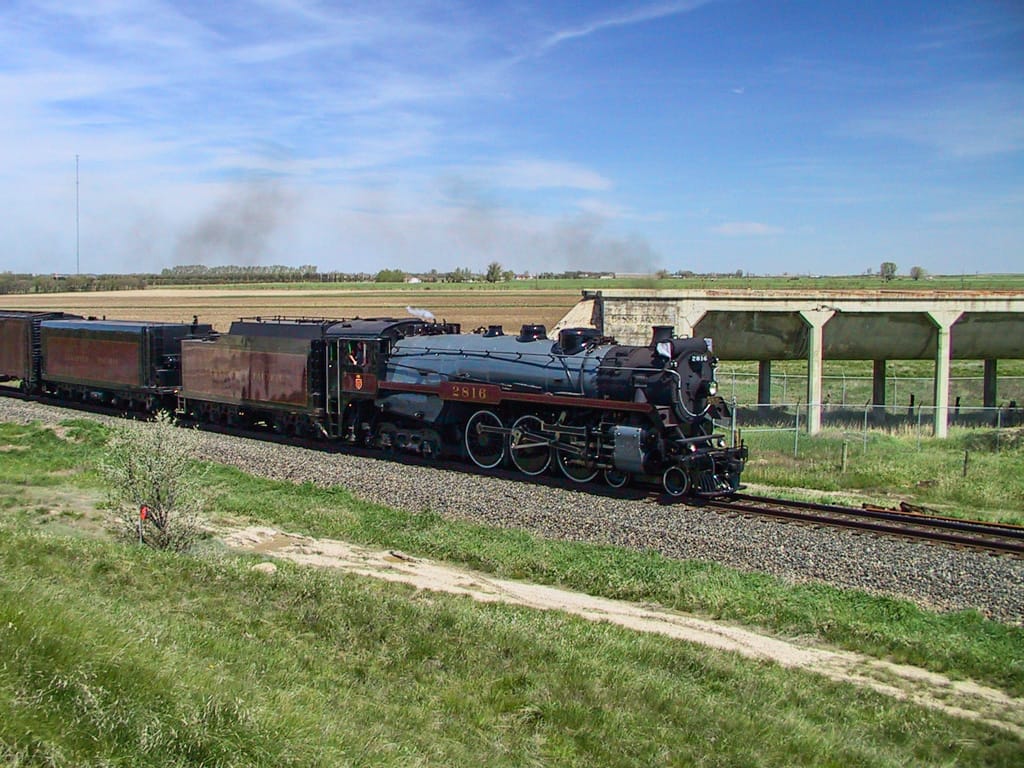While this weekend was absolutely amazing, too many of these and I’ll die from exhaustion.
I started early Saturday morning. Those of you who are chiming in with “must be train stuff” can smile smugly — ‘cuz you’re right. But it wasn’t with 6060. This was my first chase since 6060 last year, and this was a lot more challenging. 6060 doesn’t move very fast — it can’t because of the track it runs on. This chase, however, was significantly faster.
The Canadian Pacific Railway is taking their steam locomotive, 2816, out east on the “Breakfast for Learning” tour. It’s the biggest run they’ve done since the engine was overhauled. From here to Toronto and back, in about 45 days, making a lot of stops between here and Toronto. Saturday was their first leg, from Calgary to Medicine Hat. And I wanted to follow it across the prairies.
I decided I would pick up the train at the old CP Ogden shops (now owned and operated by Alstom). Although the east end of Alyth had a great place to take a picture with a bridge, the light wasn’t cooperative, and there was no place to park my car. I was the first to show up at my location, but I was soon joined by a few others: the director who was responsible for the locomotive and the train, one of the other members of the Rocky Mountain Rail Society, the parents of one of the train’s crew, and a guy who had been born and raised in the Ogden area and who’s father had opened the nearby Ogden Garage in the 1920s.
The train was to leave at 7:00, but started off the day running late, for some reason. When it finally reached us, around 7:20 or so, it looked gorgeous, and running beautifully. It passed by at about 30 km/h — not very fast. Not yet, anyway. Piling into my car, I gave chase.

I was hoping to catch the train at the east end of the intermodal yard on the east side of the city. But due to a wad of people getting in my way, the train ended up alluding me. Because of the much warmer weather than the last time I chased 2816, there was no steam cloud to see at a distance. All I had to rely on was the fireman every so often putting too much oil in the burner and creating a bit of smoke. I still don’t have a scanner, which makes following the train’s progress very difficult.
Passing the intermodal yard, I started onto a gravel road, with two other cars in front of me. I couldn’t see anything but the dust cloud they kicked up. Finally, we reached a paved road, and I turned south to try and catch up. I reached 22X, and headed east again. I had no idea where the train was, other than it was ahead of me.
The new map I had purchased at the ESSO station actually showed where the railway went, and I still had to go a fair bit south to find the line again. That’s the problem with chasing trains on the prairies — the highways rarely follow the tracks. At least on the Laggan sub, I can keep up because there ain’t a lot of room — and there the highway does follow the railway.
I raced down Highway 24, hoping I’d be able to catch the train down there. Just as I came over a hill near to where the 24 turns east, I saw the train coming to the crossing. I arrived mere seconds before the train crossed it, but I didn’t have time to get a picture. The chase was on again!
Further down the road, I stopped in a farmer’s field east of Carseland to take a picture. As the railway was curving away again, I had to race down more highways to hook back up again. I turned out on to Highway 817 and then onto 901 to continue following. At this point, the train wasn’t too hard to follow — the tracks weren’t too far from the road. The train got held up in Strangmuir for 15 minutes to undergo some greasing, which allowed me to find a comfy little field that sported a small bridge that the train was going to go over. There I found one of CP’s rail traffic controllers (RTCs), who dispatched the Brooks sub (the line we were both chasing down). He didn’t go on shift until noon, so had some time to chase.

I caught the train again where the tracks cross the 901, along with a few others including an A-Channel truck. Then to Gleichen, where I met a rather racist CP police officer, snapped a photo, and ran off to Cluny. There, I met up with the RTC again. He suggested Bassano as the next decent stop, so off we went. This time, I followed him, and it was good that I did. He led me right to the best spot to get a picture. Pretty much where everyone else chasing the train was: an old CP railway station and a rather large yard.

There I met a couple of far more professional photographers who suggested my next venue: the Brooks Aqueduct. Once the train had left, we were off. Brooks is about 180 kilometres southeast of Calgary, heading towards Medicine Hat. Brooks is pretty much the last stop before you enter the vast, barren plains of the southern prairies. There ain’t much in Brooks, which really surprised me when I saw on my map a marker for “Brooks Aqueduct National Historic Site”. It wasn’t too hard to find. All you have to do is find the sign on the highway, and drive south until you see a huge concrete aqueduct, like a modern version of a Roman aqueduct.
But modern it isn’t. I parked in the interpretive centre’s lot, and was immediately met by Lee, one of the two interpreters at the site. She was a little puzzled by why I was there — though most of their visitors come from Calgary. I explained that I was chasing a train. Yes, I did get a rather strange look. She recommended that I walk down the aqueduct canal to the siphon, which was apparently the best place to see trains in the area. Thanking her for the advice, and promising to come back, I went off in search of my quarry.
The canal is a huge earthen trench built up on the floor of the shallow valley that Brooks sits in. Barely 100 metres to the north of the canal is the old aqueduct, no longer in service. (More on it in a moment.) I walked until the canal “ended” at the railway — where an inverse siphon runs under the railroad and re-enters the canal on the other side. The siphon works on the venturi principle — basically, what goes in has gotta come out.
I was well ahead of the train, which gave me a lot of time to wander around and find the best place to take a picture. By the time I’d found the ideal place, three more photographers showed up, including the guys who’d told me about the place. We took our positions and waited.
Soon, the light appeared in the distance, and the train raced towards us. Though not going at full speed, it didn’t take long to pass. I have to completely agree with Lee and the photographers — the aqueduct was the best place to see this train.

I returned to the interpretive centre, where Lee came out to meet me. I asked her for her perspective on the aqueduct. (I told you I was getting back to this.) Back in the early 1900s, CP was in the colonizing business. There was a lot of money to be made in bringing people to the west. Especially if you’d bought all the land around the railway tracks when you built them, and sold it off to the immigrants who paid you to come west. However, not all parts of the west were ideal for farming — some are quite dry.
Such is the case with the area east of Brooks. No significant rivers, no lakes, and little rainfall poses a lot of problems. To make the area saleable, CP had to provide water for irrigation. This lead to the need to dam the Bow River at Bassano, then move the water through canals to the east. At Brooks, the land forms into a shallow valley that created a problem — without massive (and expensive) pumps, there was no way to get the water to the east. CP’s engineering department came up with the solution: the Brooks Aqueduct.
At 3.2 kilometres long, and upwards of 90 feet tall, it was the largest aqueduct in the world at the time. It pushed all the boundaries of construction knowledge, which also led to problems. Most revolutions don’t go off very well the first time. The alkaline water dissolved the concrete, the lead expansion joints leaked constantly, the spars across the top of the sluice caused backflow, and the 0.01% grade kept the water moving so slowly that silt, plants, and even fish slowed the water flow. The aqueduct only ever reached 2/3 of its planned capacity. After an extensive and expensive overhaul in the 1930s, the aqueduct was turned over to the local farming collective.
By the 1970s, the aqueduct was costing too much to repair. The local governments decided to replace it with an earthen canal that provided more water than the aqueduct ever could have (even if it had reached full capacity), and doesn’t leak. The old aqueduct was made a National Historic Site in the 1980s.
I drove down the length of the aqueduct to get a good look at it. Well, as much as I could. Once decommissioned, the aqueduct no longer received maintenance. To prevent injury, a fence runs around the perimeter. A gap in the fence did allow me to sneak in for a couple of pictures from underneath. The western end, completely cut off from the original water supply, is now home to the local party hangout, identified from the graffiti, countless broken beer bottles, and the still-smouldering remnants of a fire. The view down the aqueduct is something else.
It was about then that I noticed the time: 12:45. I needed to be back in Calgary for a party at 14:00. I was going to be late.
I pulled into the car wash at 16th Ave. and Edmonton Trail just before 15:00. The car had turned a brownish green (from all the dust), with multicoloured speckling (from all the bugs). It was shiny in only a few minutes. Then it was my turn to get clean.
I arrived at Shantie’s house just before 16:00. This was a soccer party, and as near as I could figure, I was one of the only non-soccer people invited. Needless to say, I wasn’t too keen to leap right into the game. Mostly because I haven’t played since high school, and even then I was terrible. I resolved to sit in the weak shade of a tree (not all the trees here have sprouted leaves yet) and take pictures. The six-year old daughter of one of the guests noticed it right away and asked if she could use it. It’s a durable little thing, and I figured — could get some interesting pictures.
The girl, Shayla, took almost 150 pictures over the next few hours.
The game ended around 17:00 and we retreated to Shantie’s house (across the street from the soccer field) to engage in conversation and food. John (one of the other guests) tried to engage in a battle of wits with Shayla. The six year old won, hands down. It was just the beginning.
Shantie has some really great friends. They’re hilarious to hang around with, and are in no way exclusionary. They even knew when to pick on me because I brought veggie burgers. (Relax, I haven’t gone vegan — but I’ve had these sitting in my freezer for a year, and I gotta eat ’em.)
I ended up talking with Lindsay for over an hour about Japan. (She’d been there in high school.) We talked until it was just too cool to be away from the fire pit everyone else had gathered around. (I should note that it was gorgeously warm, and it was just a slightly cool breeze that was making it uncomfortable. Besides, we were feeling left out.)
By midnight, everyone had left, including myself. I’d been up for 18 hours, was harbouring a half-dozen sunburns, and needed some serious sleep.
Today was the Lilac Festival in Calgary. I didn’t go to it this year, as I felt I had more pressing things to take care of: namely the small army of dandelions that were laying siege to my front lawn. Screwdriver in hand, I went to eradicate the little buggers from my grass.
Most people use chemicals when they get rid of weeds. I’m not a big fan of chemicals in the yard, not even fertilizers. I prefer the natural, brute force methods. I even use an unpowered push mower to cut my grass. Yeah, it’s hard work, but you feel better for it. Especially when total strangers thank you for not using chemicals.
While there was still a lot of afternoon left, I went for a walk along the river, taking in the sights and sounds of the World Walk, or something like that, taking place at Prince’s Island Park. I didn’t spend long, so I don’t really know what it was all about. I had a mission: I needed to get my bike.
People were everywhere. Calgary becomes very active when it gets warm. When there’s a festival on, you almost have problems moving at times. Along all the major strips, the patios are open and full. Everyone is enjoying the outdoors again. Summer is definitely here.
Now if it would just rain so we could all cool off…
